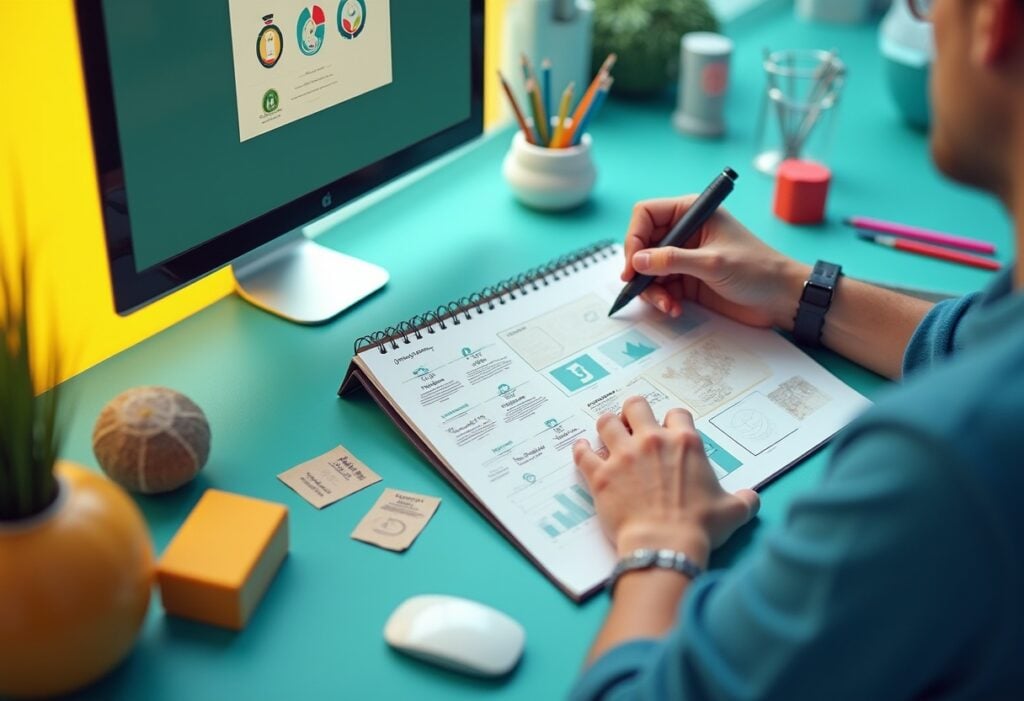When you’re planning a new website – or improving the one you’ve got – you’ll come across two common terms: web design and UX design. They sound similar, and yes, they’re definitely related. But they’re not the same thing. Understanding how they differ (and how they work together) is key to building a website that doesn’t just look great, but works hard for your business too.
Let’s unpack the differences in plain English – no jargon, just the facts.
So, what exactly is web design?
Web design is all about how your website looks. It covers the layout, colours, fonts, images, and overall visual style. If UX design is the journey, web design is the scenery.
Think of your web designer as your brand stylist.
They’ll take your colours, logo, and tone of voice, and turn them into a cohesive digital space.
A good web designer ensures that your website:
- Looks professional and on-brand
- Is easy to read and navigate
- Works beautifully on mobile, tablet and desktop
- Supports your goals, whether that’s bookings, sign-ups or sales
Web designers also make sure your website doesn’t just sit there passively – it speaks to your audience.
And what about UX design?
UX stands for “user experience.” It’s the part of web development that focuses on how people interact with your site – how they move from page to page, how easy it is to find what they need, and whether it’s enjoyable (or frustrating) to use.
Where web design is about look and feel, UX design is all about flow and function.
A UX designer is like your customer tour guide.
They map out the most logical, stress-free route for people to take on your site, asking questions like:
- What’s the first thing someone wants to do when they land here?
- How quickly can they find key information?
- Where might they get stuck or confused?
UX designers use research, testing, and behavioural data to build layouts that feel intuitive and easy – no second-guessing needed.
Wait – aren’t they just two sides of the same coin?
Sort of. They’re part of the same website team, but they focus on different things.
| Web Design | UX Design |
| How your site looks | How your site works |
| Colours, fonts, layout | Structure, user flow, functionality |
| Tools like Figma, Webflow | Tools like Figma, Hotjar, Maze |
| Visual impact | Behavioural insight |
| More design-driven | More research-driven |
UX design looks at the whole journey, often long before and after someone visits your site. Web design comes in during the production stage – when it’s time to make everything look great and feel consistent.
The best websites happen when these two disciplines work hand-in-hand, rather than in silos.
Why is UX design such a big deal?
You might be thinking: “If my website looks good, isn’t that enough?” Not quite.
A good-looking site might win people over for a second. But if it’s confusing, slow, or frustrating, they’ll bounce. Fast.
UX design helps prevent that. It makes the journey clear, the content accessible, and the entire experience – from first click to final conversion – smooth and enjoyable.
Here’s what strong UX design can do:
- Boost your conversions – because visitors can actually do what they came to do
- Lower your bounce rate – no more clicking away in confusion or frustration
- Support your SEO – search engines favour websites that offer a great user experience
- Reduce dev costs later – solving problems early on means fewer reworks post-launch.
Can you have one without the other?
Technically? Yes. But we wouldn’t recommend it.
Focusing only on visuals might give you a stunning website that’s a nightmare to use. Prioritising UX alone might give you a super-smooth journey, but it will be wrapped in a bland, uninspiring package.
In the real world, you need both – design that’s backed by strategy, and strategy that’s expressed through brilliant design.
At Yellowball, we partner closely with clients to bring UX and web design together from day one to create a powerful custom website. That way, you’re not choosing between good-looking or high-performing – you’re getting both.
How do web and UX designers actually work together?
A great website starts with strategy, not software. Here’s how web design and UX design typically play out on a project:
1. Discovery and research
We work with you to understand your audience, goals, and challenges. UX designers might run user interviews, a UX audit, or dig into analytics.
2. Wireframes and structure
The UX team maps out content, page flows and calls-to-action, building wireframes and prototypes as blueprints.
3. Visual design
Web designers bring these layouts to life, injecting brand personality, colour, and polish.
4. Prototypes and testing
We build interactive mockups and test with real users (or simulate their behaviour) using the best tools in the business.
5. Build, test, refine
Design and development teams work closely to roll out your new site, continuously refining based on feedback.
No guesswork. Just insight, collaboration, and creative thinking.
What are some signs your website has UX design issues?
Not sure if UX is holding your site back? Keep an eye out for:
- High bounce rates – are users leaving after just one page?
- Low conversions – are people dropping off before completing actions?
- User complaints – are they emailing you instead of finding info easily?
- Messy mobile layouts – is the experience frustrating on small screens?
- Slow load times or confusing navigation – that’s a red flag
All of these could suggest that your site isn’t meeting user expectations. A quick UX audit can reveal where changes are needed.
Should you focus more on web design or UX design?
If you’re redesigning your site or launching something new, the short answer is: don’t choose – combine them.
Design without user insight is guesswork. Strategy without good design can fall flat. The most successful sites strike a balance between function and flair.
At Yellowball, our approach is always practical and commercial. We don’t just want to impress – we want to help your site perform, grow, and connect.
How do UX and web design impact SEO?
You might think SEO is all about keywords and backlinks—but search engines look at the bigger picture. The way your site is designed and how users experience it play a huge role in how well you rank. Google prioritises websites that load quickly, are easy to navigate, mobile-friendly, and keep users engaged.
If your design is cluttered or your site is hard to use, visitors are more likely to bounce—sending signals to search engines that your site isn’t meeting user needs. Poor navigation, confusing page layouts, or slow loading times can all negatively affect your SEO performance.
On the flip side, strong UX and thoughtful web design work together to improve important SEO metrics: longer time on site, more pages visited, and higher conversion rates. These help Google see your site as trustworthy, relevant, and worth ranking.
When we design websites at Yellowball, we don’t just focus on visual appeal—we consider how design and user experience directly support discoverability, engagement, and business growth.
How can Yellowball Help You?
We’ve built websites across all industries – from fast-moving startups to established global brands – and the same principles always apply: your site should look great, feel natural to use, and support your commercial goals.
By combining our web design and UX design teams from the start, we deliver websites that:
- Reflect your brand’s identity
- Guide your users logically and comfortably
- Encourage clicks, sign-ups, calls and purchases
- Are tailored to your audience and sector
Every project is collaborative, transparent, and backed by strategy. We don’t believe in off-the-shelf solutions. We believe in websites that work for real people.
Why the best websites blend design and experience
You don’t have to choose between style and substance. With the right team, you get both.
Web design and UX design are different disciplines, but when they work together, magic happens. Your site becomes more than a brochure – it becomes a powerful tool that builds trust, drives action, and grows your business.
If you’re ready to build or refresh your website, and you want something that’s beautiful, functional, and commercially sound, it’s time to contact us and get the ball rolling.
Let’s create something your customers actually enjoy using.










